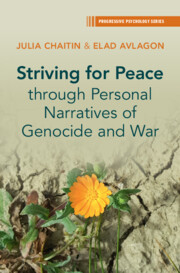Book contents
- Striving for Peace through Personal Narratives of Genocide and War
- The Progressive Psychology Book Series
- Striving for Peace through Personal Narratives of Genocide and War
- Copyright page
- Dedication
- Contents
- Preface
- Acknowledgments
- Prologue: Prehistory, Today, and Tomorrow
- Part I Theoretical Background of the Book
- Part II Personal Narratives in the Contexts of the Holocaust, Israeli–Palestinian Conflict, and Internal Israeli Divisions
- Chapter 6 Personal Narratives Connected to the Holocaust
- Chapter 7 Personal Narratives in the Jewish–Arab and Israeli–Palestinian Conflict Contexts
- Chapter 8 Personal Narratives in the Jewish–Jewish Conflict Context
- Part III Suggestions for Further Research and Peace Work on the Ground
- References
- Index
Chapter 7 - Personal Narratives in the Jewish–Arab and Israeli–Palestinian Conflict Contexts
from Part II - Personal Narratives in the Contexts of the Holocaust, Israeli–Palestinian Conflict, and Internal Israeli Divisions
Published online by Cambridge University Press: 22 February 2025
- Striving for Peace through Personal Narratives of Genocide and War
- The Progressive Psychology Book Series
- Striving for Peace through Personal Narratives of Genocide and War
- Copyright page
- Dedication
- Contents
- Preface
- Acknowledgments
- Prologue: Prehistory, Today, and Tomorrow
- Part I Theoretical Background of the Book
- Part II Personal Narratives in the Contexts of the Holocaust, Israeli–Palestinian Conflict, and Internal Israeli Divisions
- Chapter 6 Personal Narratives Connected to the Holocaust
- Chapter 7 Personal Narratives in the Jewish–Arab and Israeli–Palestinian Conflict Contexts
- Chapter 8 Personal Narratives in the Jewish–Jewish Conflict Context
- Part III Suggestions for Further Research and Peace Work on the Ground
- References
- Index
Summary
In Chapter 7, we present examples of the four different kinds of personal narratives – distancing, victimhood, ambivalence/paradoxes, and embracing the other while remaining in one’s pain – connected to the Jewish–Arab/Israeli–Palestinian conflicts that appear to have the potential either to promote peacebuilding or to obstruct peace. We address these two connected, yet not identical, conflicts together for two main reasons. While the conflicts have differences (Arabs in Israel have citizenship and Palestinians in the Palestinian Authority/Gaza Strip do not, leading to different conflictual aspects), the dilemma is the same: should Israel be a Jewish State or a state of all of its citizens? Furthermore, when people share narratives about these conflicts, they often combine the two contexts. Thus, it would be artificial to separate them. Our examples come from different sources – interviews that we undertook over the years with Jewish-Israelis and Arabs, and Israelis and Palestinians, internet sources, research books that present narrative interviews, and memoirs and autobiographies that exemplify the different kinds of narratives. This chapter, then, presents concrete examples of the different kinds of personal stories that we find in the context of speaking and/or writing about the Israeli–Palestinian conflict.
Keywords
- Type
- Chapter
- Information
- Publisher: Cambridge University PressPrint publication year: 2025

